
15 minute read
Making a difference
SURAFEL AND KIRUBEL LEMMA

HENRY HOAGLAND SAMANTHA KAUT
ANNABELLE BOWMAN

INTIMATE PORTRAITS
Matt Mendelsohn’s photographs document hopes, heartbreaks of Virginia high school seniors during pandemic
By Jen Miller
MATT MENDELSOHN ’85 didn’t know what to do when COVID-19 shut down much of the United States in March. The photographer, who is based in Arlington, Va., saw his full slate of portrait and event work “evaporate.”
“We do a lot of big events here in Washington, D.C., and everything was just canceled,” he says.
Mendelsohn did what a lot of people did that first month of the pandemic: hunkered down, got into puzzles and watched The Office for the whoknows-what-number time.
TARA HALL


PIUS ATUBIRE
CAMILLE ASHE CHARLOTTE BAXTER

JACKSON POPE
Matt Mendelsohn took portraits of about 400 members of the Yorktown (Va.) High School senior class in the spring of 2020.
In the first week of April, his daughter had a suggestion. She was then a junior at Yorktown High School in Arlington, and knew that the school’s Spring Fling would be canceled. So she asked if he would take a picture of her in her dress.
“It was a melancholy moment. She was really looking forward to it, and I felt bad,” Mendelsohn says. Even though bigger and more far-reaching losses were happening at the same time, that bad feeling stuck with him. He couldn’t sleep that night. Then, at about 2 a.m., he got an idea of something he could do: take portraits of Yorktown High School seniors.
With canceled proms and graduations, Mendelsohn felt students weren’t having the typical end-of-high-school experience.
“It’s not life or death, but a completely different kind of loss that no one was paying attention to at the time,” he says.
THE PHOTO SUBJECTS
With the help of a neighbor, and a fellow high school parent who also happens to have her own public relations firm, he was able to reach out to and take pictures of about 400 of the school’s 509 seniors. These weren’t typical high school photos, either. Mendelsohn started his career as a photojournalist, covering subjects from war zones to the White House for United Press International and USA Today.
He brought that mentality into the picture sessions: he set up a backdrop outside the students’ homes, asked them to hold or wear
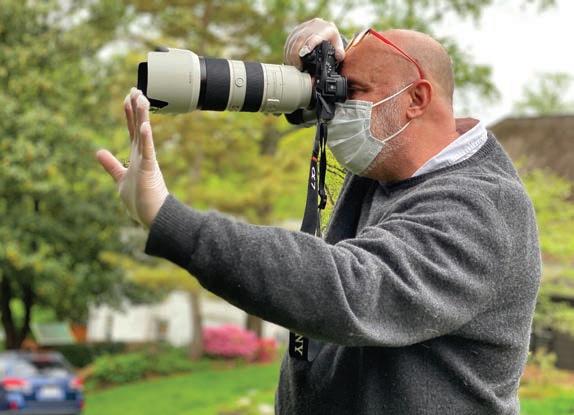
something that meant a lot to them, and took a few shots with a long lens while wearing gloves and a mask. He made sure to stand far enough away that he wasn’t putting himself or the students (or their families, who sometimes helped out) at risk. He used natural light to further cut down on what he needed to carry, and set up.
“I stood in my driveway for my photoshoot, and Mr. Mendelsohn mainly took the photos standing on the street, regularly checking to make sure that there were no cars coming through!” says Jackson Pope, who was photographed playing his violin while wearing his performance shirt, jacket and tie, and jeans.
Pope is now majoring in violin performance at Boston University. “We weren’t able to get the backdrop to stand on its own since it was particularly windy that day and our driveway is sloped, so my parents stood behind the backdrop to hold it up,” he says.
The entire process took about 15 to 20 minutes per student. Annabelle Bowman, a freshman studying dance performance and dance education at Rutgers University, recalls the sessions as “fast and furious.”
“It was clear that Matt wanted to get to know each student and personalize their photo in a way that was meaningful. He also had to balance that against the practical reality of having over 400 seniors to photograph,” she says. Picking what to do in her photo was easy: “I have been dancing my whole life,” she says, mostly ballet. So in her photo, she’s doing a piqué turn.
Tara Hall, now a freshman studying physics at Franklin & Marshall College, wore her prom dress and carried a battle-ax, which she’d made herself for a costume she wore to Katsucon, an anime fan convention held in Washington, D.C. (she dressed as Scarlet from Fire Emblem, which also required making armor).
“I already had the dress, and since prom isn’t really a thing anymore, I may as well put it to good use,” she says. Her mother helped her pick out what to hold. “We figured the contrast between the big battle-ax and the soft, flowy prom dress would be cool to look at.”
Henry Hoagland chose to wear his Junior ROTC uniform because of how much the experience meant to him in high school. He was the second in command at the Arlington County JROTC unit.
Matt Mendelsohn, a photographer based in Arlington, Va., has worked for news organizations such as USA Today and United Press International.
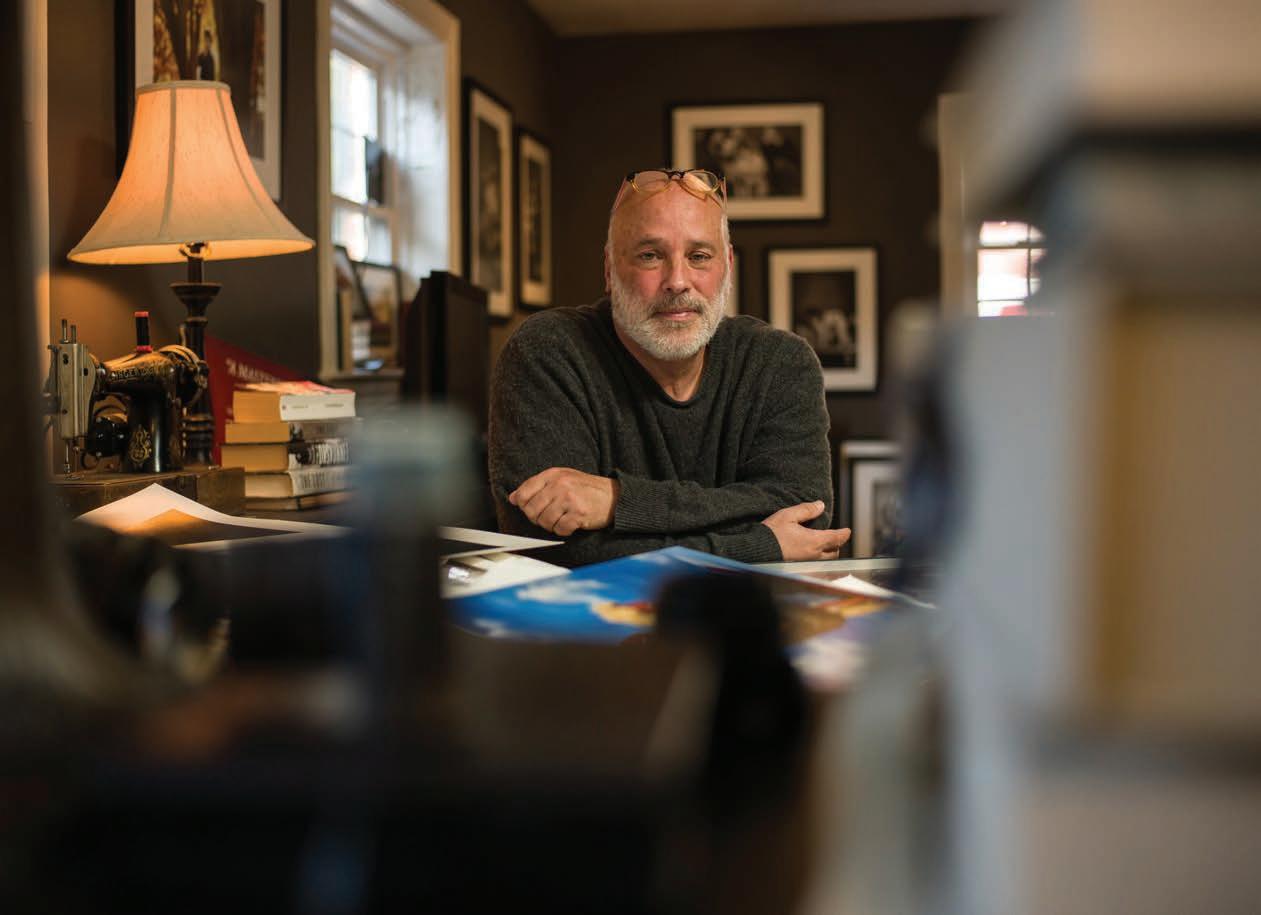
“My unit became like a second family to me, as I was generally spending three to five hours a day with them, and I knew I had to show that in Mr. Mendelsohn’s project,” says Hoagland, now in the Navy ROTC at Virginia Tech, majoring in chemical engineering.
WORLDWIDE FOCUS
What started out as a small volunteer project for Yorktown High School’s pictures didn’t stay local for long. At first, Mendelsohn posted the photos to his own Instagram account, then created instagram.com/yorktownseniors_2020 for the project. He’d ask students to answer three questions (What did you do? Where are you headed? And what do you love?), and post the answers with the pictures.
It went viral. News outlets from NBC’s Today to The Washington Post and NPR to the BBC covered the project. A German television station even called. “I’m getting emails from people in Australia saying they’ve heard about the Yorktown seniors,” he says.
While Mendelsohn was surprised by the attention, he says publicity isn’t why he took on the project.
“It was a fun way to do something for these seniors who were getting lost in the shuffle,” he says.
As for what’s next, Mendelsohn says he doesn’t know. Events haven’t come back to the level they nearly were, but he says that the Yorktown High project has introduced him to hundreds of people in his community who will need a photograph at some point.
It’s also given him a shake-up — in a good way.
“I had more fun doing (the project) than in the last 10 years of weddings and portraits,” he says. “We were doing something important to these seniors, and I’ve found that I’m being creative in ways I hadn’t been for a long time.”
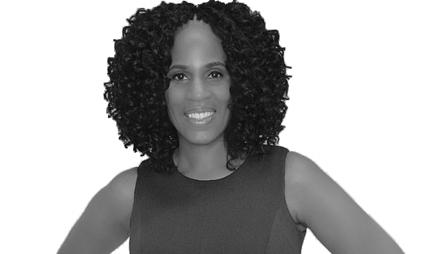
TAWANNA GILFORD
Tawanna Gilford: Calm amid the storm
Psychologist steadies the healers responding to a public health crisis
By Jennifer Micale
HARLEM HOSPITAL CENTER saw the very start of Tawanna Gilford’s life. Through the years, NYC Health + Hospitals/Harlem has provided care to friends, loved ones and fellow community members, and the Harlem-born psychologist returned in 2017 to take a position there.
Harlem has been a center of African-American life since the Great Migration of the 1920s and it was the epicenter of the Harlem Renaissance in the 1920s. It was the birthplace of many influential figures, including noted American author and activist James Baldwin, born in the same hospital as Gilford herself.
But in 2020, coronavirus scythed through the New York City metro area and nationwide, with Black communities particularly hard-hit. Healthcare workers in Harlem and elsewhere found themselves in the eye of the storm, confronting a rising tide of cases, seeing loved ones perish and risking the disease themselves as they provided essential care.
Gilford joined her colleagues on the frontlines, providing “battlefield mental health” to everyone from doctors and nurses to the registration desk,
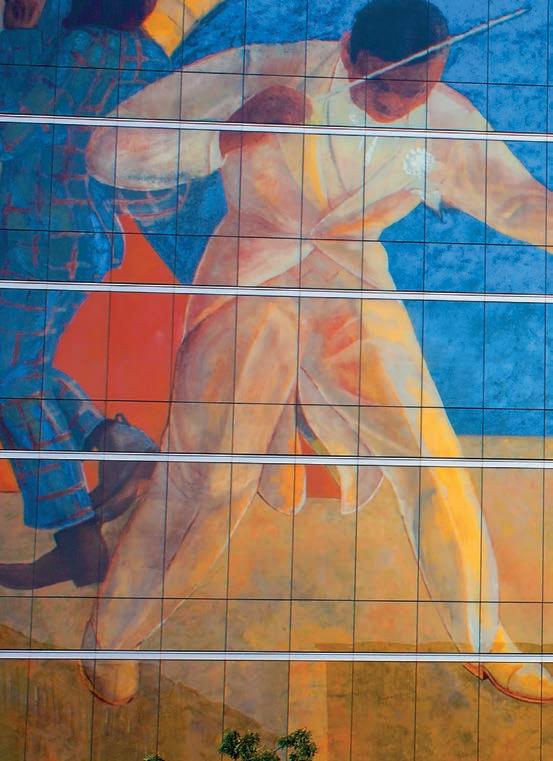
transport workers, environmental services, facilities and more in an approach spearheaded by the military.
“You go to where your responders are and offer them emotional support there,” explains the 2002 Binghamton University alumna. “People can’t leave the frontlines, so you go to the frontlines. That’s what we did. That helped significantly because we were able to offer mental health support to individuals rather than having them take time off from work.”
The head of a hospital-wide initiative called Helping Healers Heal (H3), Gilford and her team of volunteers offer emotional support to employees experiencing compassion fatigue, burnout or mental health symptoms related to the COVID-19 pandemic. Measures include one-on-one meetings and group debriefings, as well as innovative, culturally informed strategies to support emotional wellness, including creative art therapy, meditative practices, mindfulness and breathing exercises.
When adverse events happen, H3 will enter the affected department and provide a safe space to
process the situation together. Its members also visit units and conduct wellness checks before problems start. Sometimes a simple conversation can plant the seed for self-care, such as asking individuals about their weekend plans and encouraging them to consider their options.
“It helps people to know that they’re not alone. It helps support the feeling of camaraderie,” Gilford says. “It creates a safe space for people to process emotionally.”
The pandemic can have devastating effects on mental well-being, ranging from depression, anxiety and guilt from losing patients or loved ones, to frustration if an employee catches the virus on the job, even suicide. And coronavirus was far from the only societal stressor this year; Gilford points to political and civil unrest, massive unemployment and concerns about job security, all of which can take a toll.
Healthcare workers facing long hours, frightening times and risks to their own health may wonder if their sacrifice was worth it. “My role is to reinforce that it was worth it, and to encourage people that they did the right
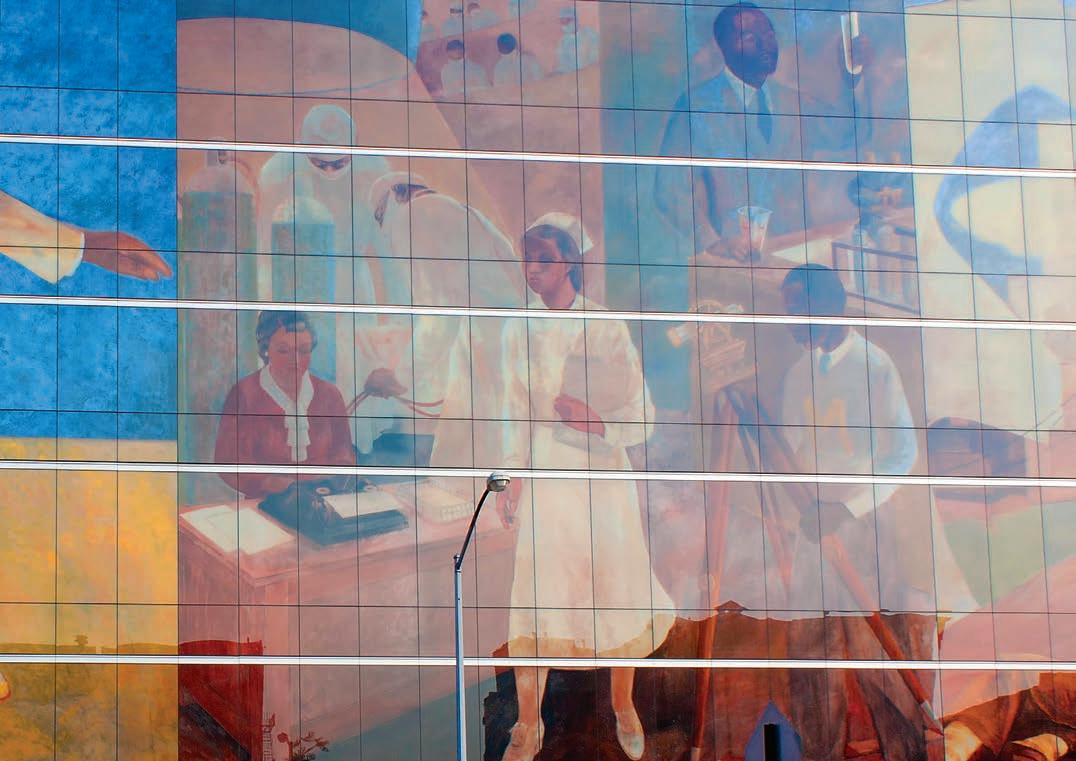
thing, and to get them past feelings of remorse and guilt,” she says.
To return home as a healer for her community, Gilford first had to journey outward. She learned about Binghamton University from a fellow cashier at the grocery store where she worked as a high school student. Her co-worker was a proud Binghamton student, chatting with Gilford about the University experience when she picked up work shifts during semester breaks and encouraging her younger colleague to pursue academic excellence. Then she invited Gilford to Binghamton for a weekend visit.
“There was the sense of home I felt when I visited the University. I was fortunate to go during a very interesting weekend; I was able to get a wide range of experiences and I attended classes with her,” Gilford recalls. “I told my family: ‘This is it!’ My heart and mind were set on Binghamton.”
While she initially intended to major in
An exterior view of NYC Health + Hospitals/Harlem (also known as Harlem Hospital Center), where Binghamton University alumna and psychologist Tawanna Gilford has led an effort to provide support to her colleagues at the facility.
Tawanna Gilford, far left, and her team of volunteers provided support to healthcare workers treating COVID-19 patients at Harlem Hospital Center. biology, her interest shifted after she took her first psychology class. The field drew her, and tapped into both her curiosity and her inner drive to help others. A dual major in psychology and sociology, her studies combined the study of the mind with the larger societal forces that shape individuals.
“It’s very results-oriented. You start off with an issue and work your way with a process,” she says

of psychology. “You aim to make things better than the way you found them.”
Three professors made a major impact on her Binghamton experience and her future path: Associate Professor of German and Russian Studies Rosmarie Morewedge, Associate Professor of Psychology Jane Connor and Professor of Human Development Leo Wilton.
Gilford worked as a teaching assistant for all three and also worked in Connor’s multicultural psychology lab, conducting research on how race influences the interactions between campus police and students. Through Connor’s lab, Gilford and a classmate organized a campus forum moderated by the Broome-Tioga NAACP, with the aim of encouraging students to talk about their experiences, similar to the conversations on equity and policing that are occurring today.
Wilton, who remains a mentor, helped Gilford find her identity as a Black psychologist. Public perception more commonly associates Black professionals with social work, Gilford acknowledges, and Black psychologists are still rare.
In 2015, 86% of U.S. psychologists in the workforce were white, while 5% were Asian, another 5% Latinx, 4% Black and 1% multiracial or from other racial or ethnic groups, according to a 2018 report from the American Psychological Association.
Wilton also encouraged Gilford to apply to Columbia University, even though she doubted herself at the time. “The field needs people like you,” he told her.
His advice and the research experience from Connor’s lab propelled her academic future: She completed her master’s at Columbia, followed by her PhD at the University at Buffalo. The two have remained in touch, and Wilton continues to encourage his former student.
Wilton describes Gilford as one of the most talented students he has taught during his years at Binghamton. She understands the ways in which people and systems interact in addressing the complexity of the structural inequities behind exclusion and marginalization, and has developed a cutting-edge conceptual model for mental health care that makes a substantial contribution to the field.
“This work has been critical — particularly at this moment — in addressing socio-cultural and structural barriers in mental health care for Black communities that experience multi-layered marginalization and structural disenfranchisement,” he says.
DIAL DOWN THE PANDEMIC STRESS
Stressed out over the pandemic? You’re not alone. Tawanna Gilford offers these two tips to help you ramp down COVID-19-related tension. • Worried that you may have been exposed to coronavirus? Get tested. Uncertainty can be a major stressor, and knowing whether or not you have the virus may help. • Avoid overconsumption of the news. While it’s good to stay informed, information overload is connected with rising levels of stress, Gilford says. Schedule a brief time of the day to read, listen to or watch the news, but limit yourself to that time.

LISSY SZALKIEWICZ
On the frontline with Lissy Szalkiewicz
For two months, Manhattan doctor cared only for coronavirus patients
By Steve Seepersaud
AFTER A NEARLY TWO-MONTH SPAN in which physician Elissa “Lissy” Szalkiewicz ’08 saw hundreds of patients, her mind can easily flash back to outcomes on both ends of the spectrum. There were patients who FaceTimed with relatives just before dying and there were patients who went home after a short hospital stay. During the peak of the coronavirus in New York City, Szalkiewicz saw a bit of everything.
Szalkiewicz works at Columbia University Irving Medical Center in Manhattan, taking care of patients admitted from the emergency room. Normally, she sees patients with a variety of conditions. In March and April, however, it was nothing but coronavirus cases.
“This was very difficult for providers, patients and families because we had to deal with something we had never seen before,” Szalkiewicz says. “Initially we weren’t sure if the patients were going to get better or worse. It’s never a good feeling when you go in to see a patient, and they’re looking good, but you’re not sure what will happen over the next few hours.
“If we were able to send them home, we didn’t know if they would need to come back or would pass away in their homes. There were times when I felt helpless.”
Szalkiewicz leaned on her medical school training and residency experience, which required her to work long hours and handle a large patient load. She also said her Binghamton University experience — she was a math major and avid co-rec player — helped her think through situations logically, anticipating what would come next and working as part of a team.
The Columbia staff was very nimble, she says, increasing the number of floors taking only coronavirus patients, expanding intensive care units (ICU) and making use of all available space.
“By coming up with unique and ingenious ideas, we were able to properly care for our patients,” Szalkiewicz says. “We had a tent outside the Emergency Department capturing patients on their way to the department. We’d see if they had coronavirus symptoms, check their vital signs and determine if they had to be admitted or if they were stable enough to return home with virtual follow-up. We rapidly recognized patterns concerning the disease presentation and course, and frequently adapted our treatments based on the newest information. We spent many hours supporting our patients and connecting them virtually with their family members who were stranded at home.”
By May, there were fewer admissions to Columbia’s hospital, more patients were being discharged and some of the recently added ICUs closed. The darkest time had passed.
“It was definitely a scary, unfathomable time for everyone, but we saw the best of people,” Szalkiewicz says. “Every night at 7, people would clap for us. The hospital got a lot of food and supply donations. When we were scared that we’d run out of PPE, companies quickly donated PPE. New Yorkers did their part in helping to stop the spread and stayed home, social distanced and wore masks. We, as healthcare professionals, really appreciate all the support.”





